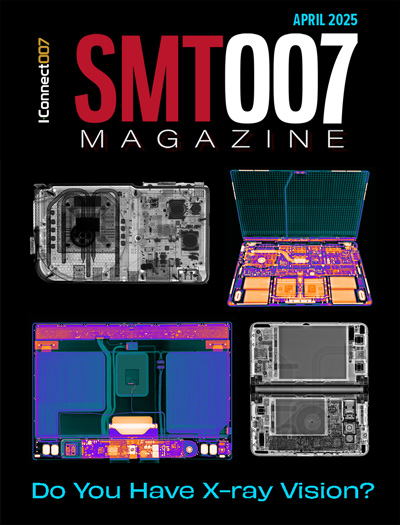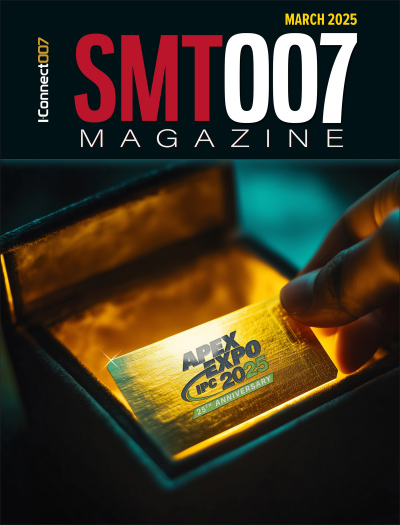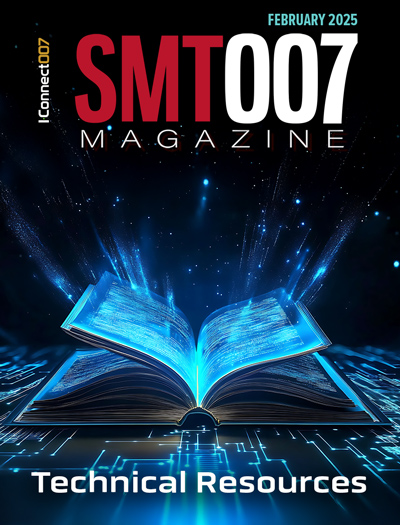-

- News
- Books
Featured Books
- smt007 Magazine
Latest Issues
Current Issue
Do You Have X-ray Vision?
Has X-ray’s time finally come in electronics manufacturing? Join us in this issue of SMT007 Magazine, where we answer this question and others to bring more efficiency to your bottom line.

IPC APEX EXPO 2025: A Preview
It’s that time again. If you’re going to Anaheim for IPC APEX EXPO 2025, we’ll see you there. In the meantime, consider this issue of SMT007 Magazine to be your golden ticket to planning the show.

Technical Resources
Key industry organizations–all with knowledge sharing as a part of their mission–share their technical repositories in this issue of SMT007 Magazine. Where can you find information critical to your work? Odds are, right here.
- Articles
- Columns
Search Console
- Links
- Media kit
||| MENU - smt007 Magazine
Aqueous Cleaning Today and Tomorrow
December 31, 1969 |Estimated reading time: 9 minutes
Much like the electronics industry as a whole, the PCB cleaning market continues to change. Not too long ago, this process was viewed as unnecessary. No-clean paste and flux were the way of the future; and cleaning was on its way out. That was then; this is now.
By Richard Burke
The industry sees many customers being challenged by the need to clean the same no-clean fluxes that were sure to have been eliminated in the industry a few years ago. Challenged by these materials because unlike traditional water-soluble (organic acid) and non-water-soluble (rosin) fluxes, no-clean fluxes were not formulated for cleaning and are more difficult to remove.
The industry continues to clean for various reasons, including cosmetic, long-term product reliability and other process requirements such as underfill and conformal-coating steps where surface adhesion is critical. Like many processes in the electronics industry, cleaning is affected by the conversion from lead to lead-free alloys. The question often asked is how will lead-free alloys affect my business as related to the need to clean? Unfortunately, one answer will not apply for all cases. Because of the elevated temperatures of reflow and wave soldering, as well as the increased contact time required in the wave for lead-free alloys, fluxes are more likely to char. This typically makes fluxes more difficult to remove and can result in more cosmetic issues for those not currently cleaning. As the lead-free conversion accelerates, so will the need for cleaning.
Successful aqueous cleaning is a multi-stage process consisting of the ability to clean and dry. Success depends on a number of variables and/or parameters that apply to the cleaning and drying processes. In terms of the cleaning portion of the process, these include chemical composition of the residue to be removed and the cleaning media (solvency), ability of the sprayed water to dislodge and rinse away the residue even when it is not completely solubilized by the cleaning media (mechanical energy), adequate exposure of the cleaning media to the residue (time) and elevated temperature of the cleaning media to accelerate the molecular breakdown of the residues to be removed. As for the drying portion of the process, mechanical energy, time and temperature are key parameters to a successful process. Before determining a particular cleaning media and/or cleaning machine configuration, it is important to understand what must be removed.
Flux residue is an expected residue, but is it water-soluble or does it require a cleaning chemical to aid in this process? This basic question is critical because it helps define what the cleaning media must be. This answer also helps define equipment requirements. A process that uses water-only is much different than one that uses a cleaning chemical. The configuration of a machine using water-only as the cleaning media is different than that of a machine using a cleaning chemical.
A batch process is best suited for low-volume/high-mix applications. This equipment generally is less expensive, but not an option for medium- and/or high-volume manufacturing environments. An in-line process, more specifically, a spray-in-air in-line process, is a versatile, accepted method for successfully delivering clean and dry electronic assemblies. Other less-common technologies include ultrasonic batch, vapor degreasing, semi-aqueous and centrifugal systems. Although less common techniques, one of these may be a suitable solution.
Stage 1: Pre-wash
The significance of the pre-wash stage is often overlooked. It is viewed as the stage where the assembly to be cleaned is pre-wet. In reality, this module begins the cleaning process and provides numerous functions depending on whether the process is water-soluble (water-only) or non-water soluble (water with a cleaning chemistry). A typical pre-wash module will consist of multiple upper and lower spray manifolds that will each have multiple flooding-style nozzles. The cleaning media (water and/or water with a chemistry) is supplied to the pre-wash module from the wash tank through the wash pump.
In a water-soluble process (organic acid flux), the pre-wash module is designed to remove most of the exposed surface flux. In this application, the pre-wash effluent is routed such that it leaves the machine rather than being returned to the wash tank. This is also suitable for removing water-soluble mask that may have been used during the wave-soldering process.
In a non-water-soluble process (RMA and no-clean fluxes), the pre-wash module acts as an extension of the wash module. Exposure of the heated wash chemistry begins to breakdown rosin and the cleaning process. In this case, the pre-wash effluent is routed back to the wash tank.
Stage 2: Recirculating Wash
This stage is the primary wash stage and must include key features. It must have the ability to establish and maintain elevated temperatures during product loading. Typical wash-bath temperatures range from 140° to 150°F for water-soluble fluxes, to 150° to 160°F for rosin-based fluxes. The recirculating wash stage must also use a delivery system capable of maximizing mechanical energy at the board level. This is more critical in assemblies with low-standoff-height components, masked and/or shadowed areas, as well as residues that do not solubilize completely in the cleaning media. Recirculating wash modules typically include some type of specialty nozzle and/or nozzles designed to ensure maximum impingent energy at the level of the residue. Effective specialty nozzles deliver a coherent sheet of cleaning media at both high volume and high pressure. These specialty nozzle types, in combination with more traditional flooding-type nozzles, ensure maximum performance.
 Figure 1. Spray bars of an in-line cleaning system.
Figure 1. Spray bars of an in-line cleaning system.
The combination of the pre-wash and recirculating wash-module length, its mechanical ability to dislodge residue, the effectiveness of the cleaning media to solubilize the residue and the difficultly of the product to be cleaned determine the speed in which the in-line cleaning system will run (Figure 1).
Stage 3: Chemical Isolation
The function of this particular stage is to minimize the drag out and/or carryover of wash chemistry from the recirculating wash module to the subsequent recirculating rinse stage. This stage is not required for water-soluble applications. However, when wash chemistry is used, this stage becomes critical to the long-term success of the in-line cleaning process. This is true when recirculating rinse water is run in a closed-loop environment, as the ionic nature of many cleaning chemistries will shorten the life of the deionized-filtration (DI) media. Operating without a well-designed chemical-isolation stage will be costly. The most effective chemical-isolation modules include several features. Adequate length is needed, as it is not enough to simply have an isolation module. If the assembly being cleaned is longer than the isolation module, enabling it to be in three modules at the same time, the module will not be effective. If this were the case, wash water could contact the assembly surface and travel directly across the assembly while located within the chemical-isolation module, flowing into the rinse tank directly. The module must also include both air and water manifolds to maximize effectiveness. As the assembly moves from the wash toward the rinse, the bulk of the wash water is removed mechanically using air knives. This water-containing chemistry is returned to the wash tank. Next, a low-volume and low-pressure water spray dilutes the remaining wash chemistry. Finally, air knives remove the bulk of the remaining already-diluted water prior to entering the recirculating rinse module (Figure 2).
 Figure 2. Chemical-isolation module.
Figure 2. Chemical-isolation module.
null
Stage 4: Recirculating Rinse
In a water-soluble process, this provides increased capacity and more exposure time to the water and mechanical spray nozzles. In a non-water-soluble application, this stage plays a more critical role as it must ensure that the wash chemistry and solubilized rosin-flux residues are rinsed from the assembly. To ensure this occurs, it is critical that the nozzle/manifold arrangement be as good as, if not better than, the recirculating-wash module. If the wash water with chemistry is able to penetrate a difficult-to-reach location, the rinse water must as well.
Stage 5: Final Rinse
This is the last of the wet stages in the in-line cleaning process. As with the pre-wash module, this stage is overlooked. Single-spray manifolds are used to reduce equipment cost at the expense of performance. Because this is the last wet stage and the stage that uses the cleanest water (often DI water ranging from 1 to 18 MΩ), it is not the place to cut costs. The intent of this stage is to dilute and rinse away any and all remaining solubilized residues from the surface of the assembly. Once sprayed, the final rinse water cascades to the rinse tank and in a water-soluble application from the rinse tank to the wash tank. This is known as a full-cascade system. In a non-water-soluble application, rinse water does not cascade to the wash tank but exits the cleaner through a weir to the facility drain or a closed-loop system.
Stage 6: Drying
Drying is the last stage of the in-line cleaning process. In this stage, water is removed from the assembly by mechanically stripping away the water and evaporating it from areas that mechanical means cannot penetrate. Mechanical removal is the most desirable as it ensures no contaminants remain on the assemblies. Any remaining contaminants are blown off the assemblies as the water is stripped away. Unfortunately, some assemblies have blind holes or low-standoff components that do not allow air from any blower and air knife combination to penetrate. In these cases, remaining water must be evaporated from the assembly. This is another reason why the use of DI water in the final rinse stage is desirable. When water is evaporated rather than removed from the assembly mechanically, any and all remaining contaminants in the water will be left on the assembly once the water is evaporated. When DI water is not used, hard-water residues can result in water spots being left behind. More serious concerns are elevated ionic residues left behind, which can cause long-term reliability problems.
The closed looping of in-line aqueous cleaning machines yield multiple benefits such as lower operating costs, improved cleaning performance and environmental compliance. The most common approach is to use carbon and ion-exchange-filtration media to remove the impurities in the water as it is passed through various media vessels. The resulting output from such a system will be DI water quality ranging from 1 to 3 MΩ. DI water of this quality is more than adequate for most electronics assemblies. If and when ultra-pure water quality is required, the simple addition of a mixed bed (MB) after the cation bed will raise water quality to 10 to 18 MΩ. For water-soluble applications, the entire cleaning machine is closed-looped, while with non-water-soluble applications, the rinse and final rinse modules are closed loop.
Conclusion
Cleaning equipment and chemical suppliers of flux, paste and cleaning chemistry will continue to work closely to ensure that the industry is well suited to work with these ever-evolving materials, especially in the lead-free arena. Equipment manufacturers will continue to advance cleaning, drying and closed-loop technologies to maximize efficiencies. Chemical suppliers will continue to formulate materials that are friendlier to the cleaning process and the environment. Answers to cleaning challenges exist, and the industry can provide proven solutions today and into the future.
Richard Burke, product manager, Electrovert product lines, Speedline Technologies, may be contacted at (508) 520-0083; e-mail: rburke@speedlinetech.com.


